HIV stands for human immunodeficiency virus. The virus attacks CD4 cells (a type of white blood cell), which help to fight infection, making it difficult for the body to fight pathogens. HIV can hide in the body for years without symptoms, but can make it more difficult for the body to fight infections it could previously fight easily. Some get flu-like symptoms soon after they become infected, but these can fade within a week.
Without management, HIV can develop into AIDS (acquired immunodeficiency syndrome), which is the final and most severe stage of HIV infection. In this stage, the person has very low white blood cell counts and a severely damaged immune system. Due to the low white blood cell count, opportunistic infections can become more difficult for the body to fight off. To be diagnosed with AIDS, a person has to have fewer than 200 CD4 cells per cubic millimeter of blood and have an AIDS-defining illness (certain neurological infections or cancers that are life-threatening in a person with HIV/AIDS).
HIV is transmitted through bodily fluids such as semen, blood, vaginal fluid, and breast milk. A person can become infected by having unprotected vaginal or anal sex or sharing needles/other injectable equipment without proper sterilization. Though the risk of HIV transmission through oral sex is extremely low, several factors may increase that risk, including oral contact with mouth or genital sores, bleeding gums, or menstrual blood. HIV cannot be spread through kissing, saliva, sweat, tears, or the air.
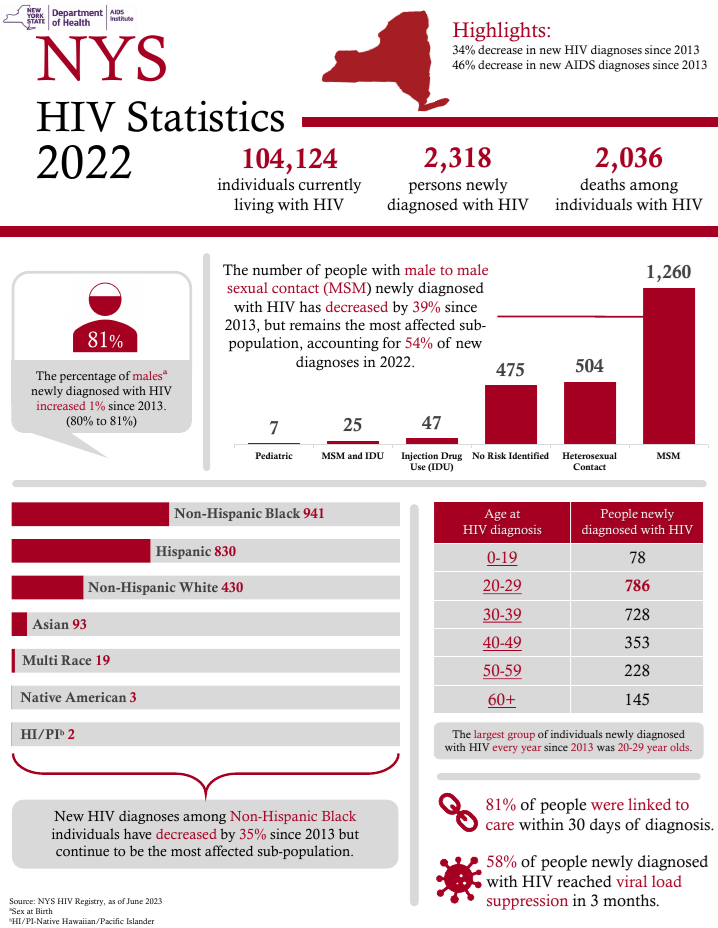
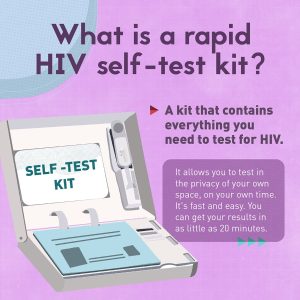

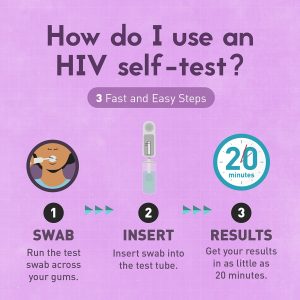
HIV can be detected through a blood, oral fluid, or urine test. There are three kinds of tests:
Antibody Tests: These detect antibodies in the blood or saliva. These are available as rapid tests and do not need to be sent to a lab.
Antibody/Antigen Tests: Can test for HIV with blood that is sent to a lab, or a rapid test with blood from a finger stick.
Nucleic Acid Test (NAT): Looks for the actual virus in the blood, as opposed to detecting antibodies (which are made by the body in response to the virus). This test can detect HIV sooner than other types, and is done by taking a blood sample from a vein and sending it to a lab. This type of test can also give information about a person’s viral load, which is a measure of how much of the virus is in the blood. A nucleic acid test would be a good option for someone who had a possible recent exposure and is testing negative with the other two test types.
Antibody and antibody/antigen tests can give results in 20-30 minutes, but it may take days to get results from a NAT. NAT’s can detect HIV quicker because they detect the actual virus, whereas antibody and antibody/antigen tests detect antibodies, which are made by the body in response to the virus, and may take some time for the body to make (this is called the “window period”). It’s important to remember, though, that no HIV test is effective right after infection because of this window period, so if you think you may have been exposed to HIV within the past 72 hours, ask your provider about PEP (post-exposure prophylaxis). More information about PEP can be found on our “safer sex” page.
Most HIV tests are available for free or are highly discounted at many clinics and hospitals. Pharmacies have self-tests that can be purchased over the counter. Visit the AIDSVu’s Service Finder (at https://aidsvu.org/services) to find a clinic, hospital, or provider that can administer HIV tests. You can also order a rapid test in the mail; for example, Trillium Health, an HIV service agency in Rochester, can send an free HIV home test kit upon request. Click on this link for more details:
https://www.trilliumhealth.org/services/trillium-at-home/request-at-home-services
The CDC recommends that all people between the ages of 13 and 64 get tested at least once, and more frequently if you’re engaging in behavior that puts you at risk for HIV. What are you waiting for? Go get tested!
There is no cure for HIV, but there are many management options that allow for those with HIV to live long, healthy lives. In fact, studies have found that someone with HIV can live just as long as someone without it if they are diagnosed early, have access to proper medical care, and are able to stick to their treatment plan. That’s why catching it in time by getting tested regularly, getting necessary medical support, and starting treatment as early as possible is important.
Antiretroviral therapy (ART) involves taking a combination of pills (a treatment regimen) every day. The actual treatment plan can vary from person to person, so a provider will work with a patient to design a treatment regimen specific to their needs. ART works by stopping the virus from replicating. As discussed earlier, the severity of HIV infection largely depends on the viral load, a measure of how much of the virus is in the system, so interfering with replication can greatly slow down disease progression. This also allows the body to produce more CD4 white blood cells, which HIV destroys.
When taken as prescribed, ART can keep HIV patients healthy. Side effects are usually not major, but healthcare providers agree that the benefits of ART far outweigh the potential side effects. Those benefits include safety for an HIV-positive individual’s sexual partner(s) – it is impossible to transmit HIV if a person’s viral load is “undetectable” – that is, even though the person is still infected, the amount of virus in the body is too low to be measured!
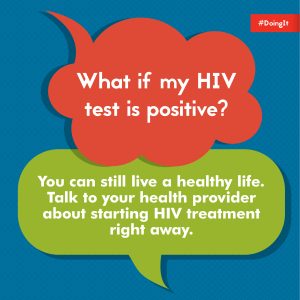
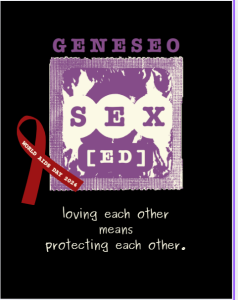
The information on this site is for educational purposes only. It does not replace a personal relationship with a licensed health care provider and is not intended to provide medical advice. We strongly recommend that you make your health care decisions based on your own research and knowledge of your body, in collaboration with one or more licensed health care providers.
The hosting for this website is provided by SUNY Geneseo as a courtesy, but it is not an official College publication. The statements and opinions expressed in content of this website do not represent the official position or policy of SUNY Geneseo.